Rare-Earth Fluorite-like Li0.42La4.58Mo3O15.76±δF0.42±ε Molybdates: Crystal Growth and Atomic Structure
Abstract
:1. Introduction
2. Materials and Methods
3. Results and Discussion
3.1. Powder X-ray Diffraction and Elemental Analysis
3.2. Crystal Structure
4. Conclusions
Author Contributions
Funding
Data Availability Statement
Acknowledgments
Conflicts of Interest
References
- Hubert, P.H.; Michel, P.; Thozet, A. Structure du molybdate de néodyme Nd5Mo3O16. C. R. Hebd. Seances Acad. Sci. Ser. C 1973, 276, 1779–1781. [Google Scholar]
- Istomin, S.Y.; Kotova, A.I.; Lyskov, N.V.; Mazo, G.N.; Antipov, E.V. Pr5Mo3O16+δ: A new anode material for solid oxide fuel cells. Russ. J. Inorg. Chem. 2018, 63, 1274–1279. [Google Scholar] [CrossRef]
- Tsai, M.; Greenblatt, M. Oxide ion conductivity in Ln5Mo3O16+x (Ln = La, Pr, Nd, Sm, Gd; x~0.5) with a fluorite-related structure. Chem. Mater. 1989, 1, 253–259. [Google Scholar] [CrossRef]
- Voronkova, V.I.; Leonidov, I.A.; Kharitonova, E.P.; Belov, D.A.; Patrakeev, M.V.; Leonidova, O.N.; Kozhevnikov, V.L. Oxygen ion and electron conductivity in fluorite-like molybdates Nd5Mo3O16 and Pr5Mo3O16. J. Alloys Compd. 2014, 615, 395–400. [Google Scholar] [CrossRef]
- Biendicho, J.J.; Playford, H.Y.; Rahman, S.M.H.; Norberg, S.T.; Eriksson, S.G.; Hull, S. The fluorite-like phase Nd5Mo3O16±δ in the MoO3–Nd2O3 system: Synthesis, crystal structure, and conducting properties. Inorg. Chem. 2018, 57, 7025–7035. [Google Scholar] [CrossRef] [PubMed]
- Martinez-Lope, M.J.; Alonso, J.A.; Sheptyakov, D.; Pomyakushin, V. Preparation and structural study from neutron diffraction data of Pr5Mo3O16. J. Solid State Chem. 2010, 183, 2974–2978. [Google Scholar] [CrossRef]
- Alekseeva, O.A.; Gagor, A.B.; Pietraszko, A.P.; Sorokina, N.I.; Bolotina, N.B.; Artemov, V.V.; Kharitonova, E.P.; Voronkova, V.I. Crystal structure of the oxygen conducting compound Nd5Mo3O16. Z. Kristallogr. 2012, 227, 869–875. [Google Scholar] [CrossRef]
- Faurie, J.-P. Préparation de nouvelles phases MLn4Mo3O16, MLn6Mo4O22 de structure dérivée du type fluorine. Bull. Soc. Chim. Fr. 1971, 11, 3865–3868. [Google Scholar]
- Antipin, A.M.; Sorokina, N.I.; Alekseeva, O.A.; Kharitonova, E.P.; Orlova, E.I.; Voronkova, V.I. Crystal structure of fluorite-like compound based on Nd5Mo3O16 with lead partly substituting for neodymium. Acta Crystallogr. 2015, B71, 186–193. [Google Scholar] [CrossRef]
- Voronkova, V.I.; Kharitonova, E.P.; Orlova, E.I.; Levchenko, A.V.; Antipin, A.M.; Sorokina, N.I.; Belov, D.A. Ca-doped fluorite-like compounds based on Nd5Mo3O16. J. Alloys Compd. 2016, 673, 314–320. [Google Scholar] [CrossRef]
- Vu, T.D.; Krichen, F.; Barre, M.; Busselez, R.; Adil, K.; Jouanneaux, A.; Suard, E.; Goutenoire, F. Crystal structure and ion conducting properties of La5NbMo2O16. J. Solid State Chem. 2016, 237, 411–416. [Google Scholar] [CrossRef]
- Antipin, A.M.; Sorokina, N.I.; Alekseeva, O.A.; Zubavichus, Y.V.; Artemov, V.V.; Kharitonova, E.P.; Orlova, E.I.; Voronkova, V.I. Structure of Nd5Mo3O1+δ single crystals doped with tungsten. Crystallogr. Rep. 2018, 63, 339–343. [Google Scholar] [CrossRef]
- Antipin, A.M.; Alekseeva, O.A.; Sorokina, N.I.; Verin, I.A.; Novikova, N.E.; Furmanova, N.G.; Kharitonova, E.P.; Voronkova, V.I. Single-crystal structure of vanadium-doped Nd5Mo3O16. Crystallogr. Rep. 2014, 59, 141–145. [Google Scholar] [CrossRef]
- Voronkova, V.I.; Kharitonova, E.P.; Orlova, E.I. Synthesis and electrical properties of a fluorite-Like Nd5Mo3O16 compound with partial substitution of molybdenum by tungsten, niobium, or vanadium. Crystallogr. Rep. 2018, 63, 127–131. [Google Scholar] [CrossRef]
- Voronkova, V.; Kharitonova, E.; Orlova, E.; Kezionis, A.; Petrulionis, D. Effect of sodium and fluorine co-doping on the properties of fluorite-like rare-earth molybdates of Nd5Mo3O16 type. Eur. J. Inorg. Chem. 2019, 9, 1250–1256. [Google Scholar] [CrossRef]
- Voronkova, V.; Kharitonova, E.; Orlova, E.; Baldin, E.; Gorshkov, N.; Goffman, V.; Chernyak, S. Fluorite-like LixLn5−xMo3O16.5−1.5xFx (Ln = La, Pr, Nd) compounds isostructural with Nd5Mo3O16. J. Am. Ceram. Soc. 2020, 103, 6414–6423. [Google Scholar] [CrossRef]
- Baldin, E.D.; Sorokin, T.A.; Orlova, E.I.; Gorshkov, N.V.; Kharitonova, E.P.; Lyskov, N.V.; Goffman, V.G.; Voronkova, V.I. Proton conductivity in rare-earth fluorine-containing molybdates NaLn4Mo3O15F. Russ. J. Electrochem. 2023, 59, 54–59. [Google Scholar] [CrossRef]
- Petřiček, V.; Dušek, M.; Palatinus, L. Crystallographic computing system JANA2006: General features. Z. Kristallogr. 2014, 229, 345–352. [Google Scholar] [CrossRef]
- Rigaku Oxford Diffraction. CrysAlisPro Software System, Version 42.74a; Rigaku Corporation: Oxford, UK, 2018. [Google Scholar]
- Palatinus, L. Ab initio determination of incommensurately modulated structures by charge flipping in superspace. Acta Crystallogr. A 2004, 60, 604–610. [Google Scholar] [CrossRef]
- Swanson, H.E.; Tatge, E. Standard X-ray diffraction powder patterns. Natl. Bur. Stand. (U.S.) Circ. 1953, 539, 1. [Google Scholar]
- Tarasova, N.A. Effect of fluorine doping on the ionic (O2−, H+) conductivity of oxygen-deficient complex oxides. Russ. Chem. Bull. 2020, 69, 1253–1263. [Google Scholar] [CrossRef]
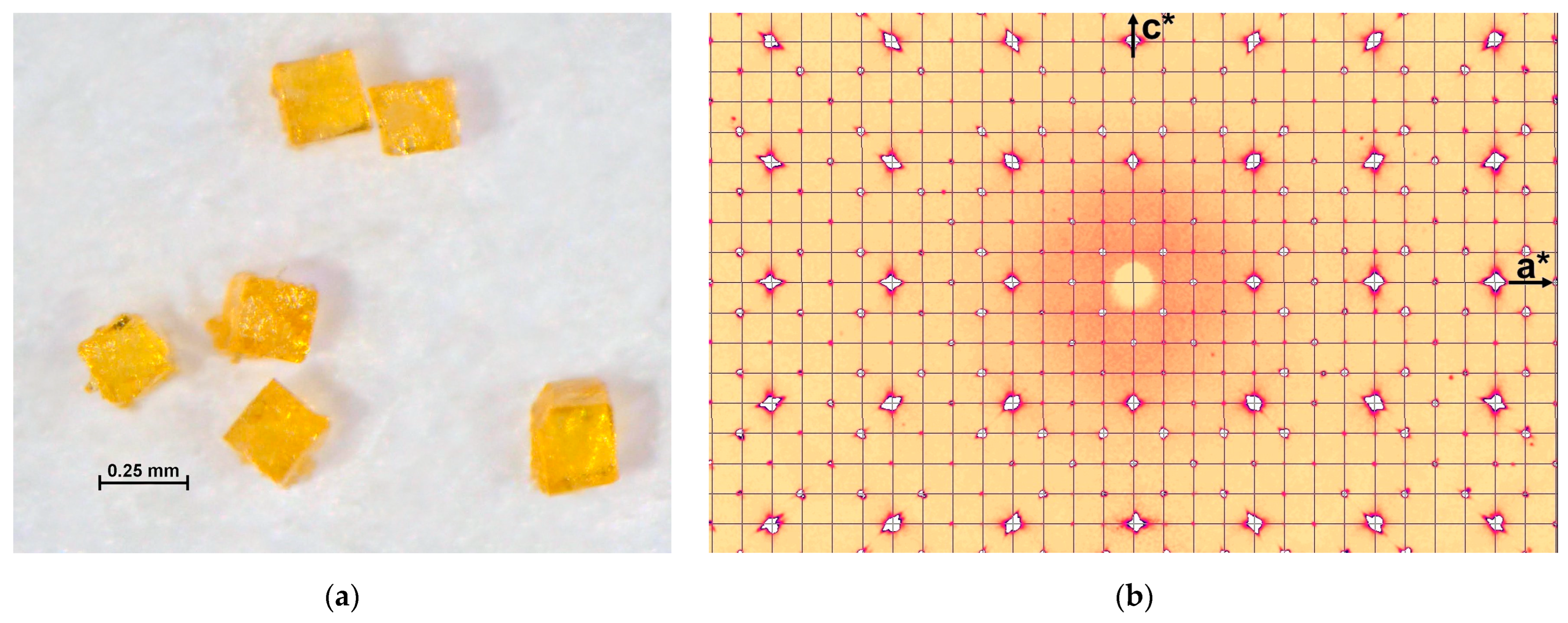
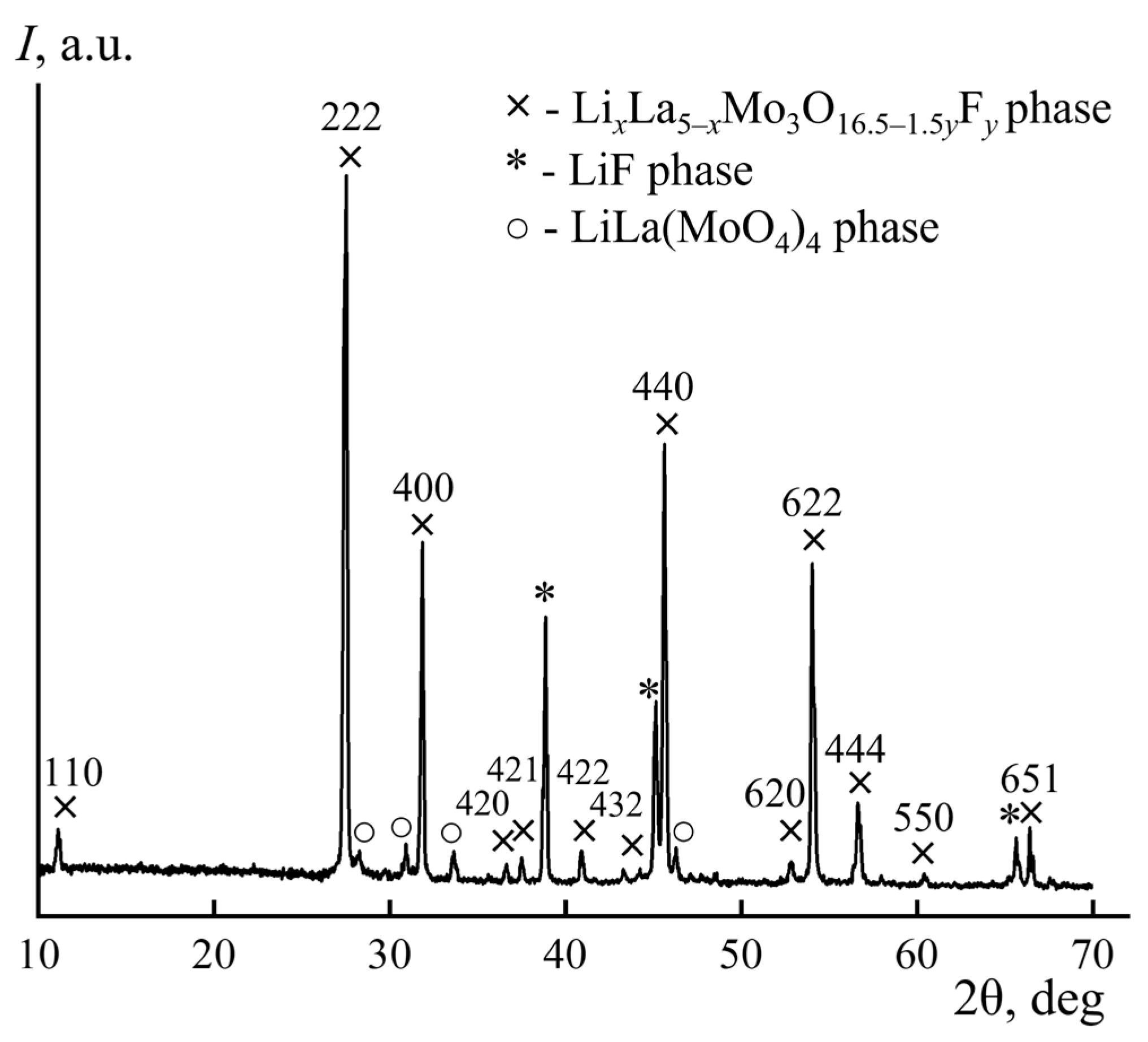
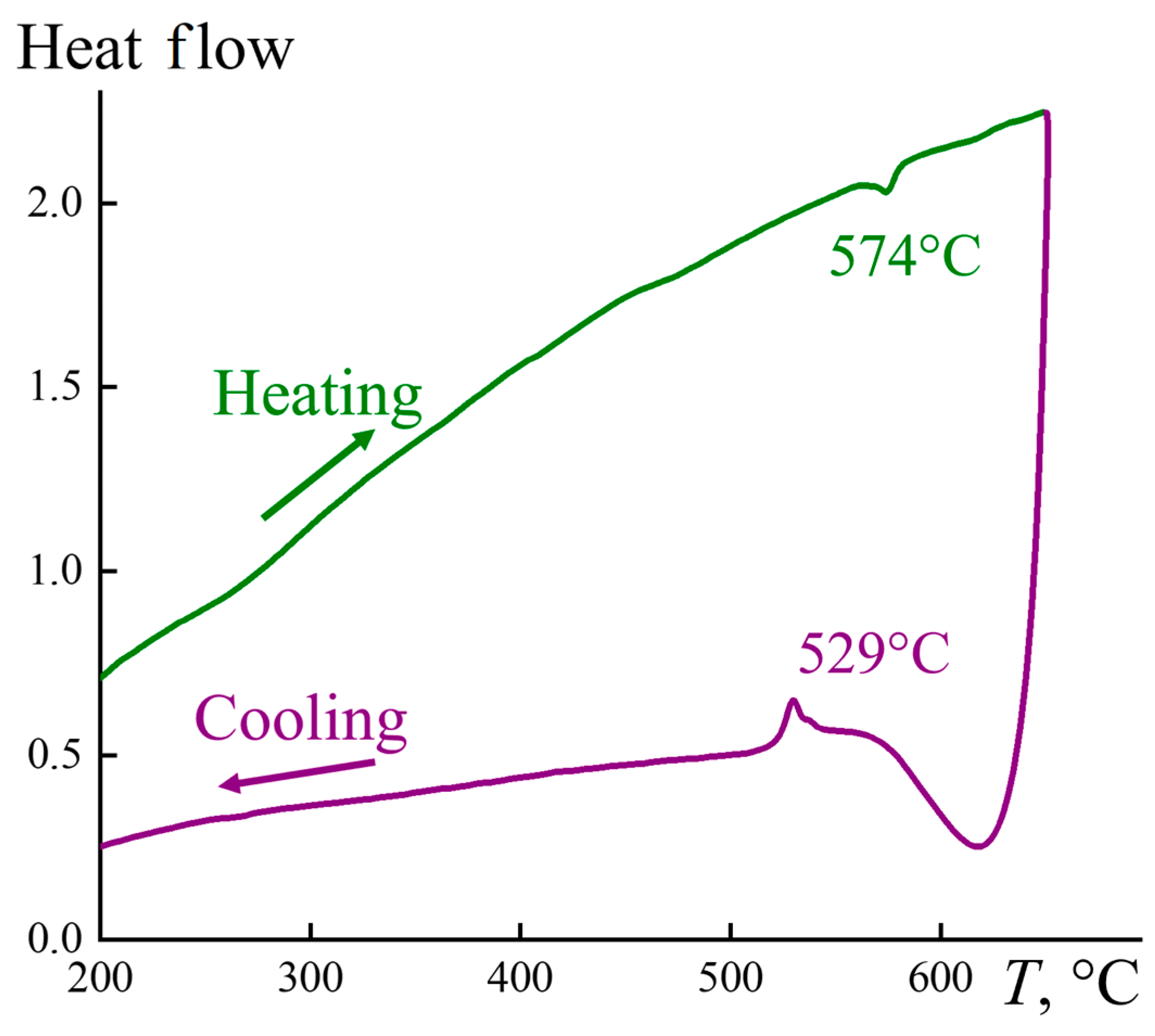
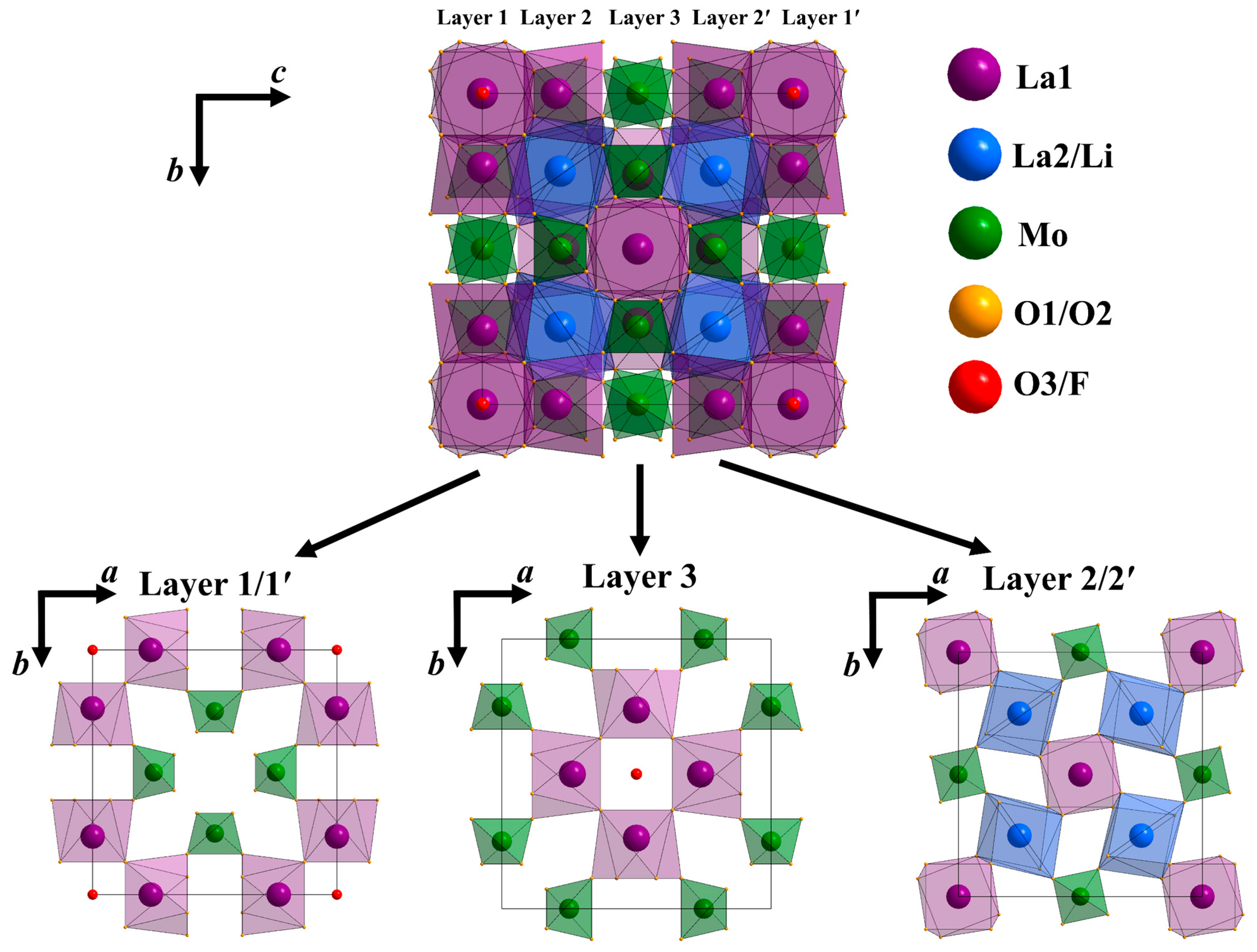
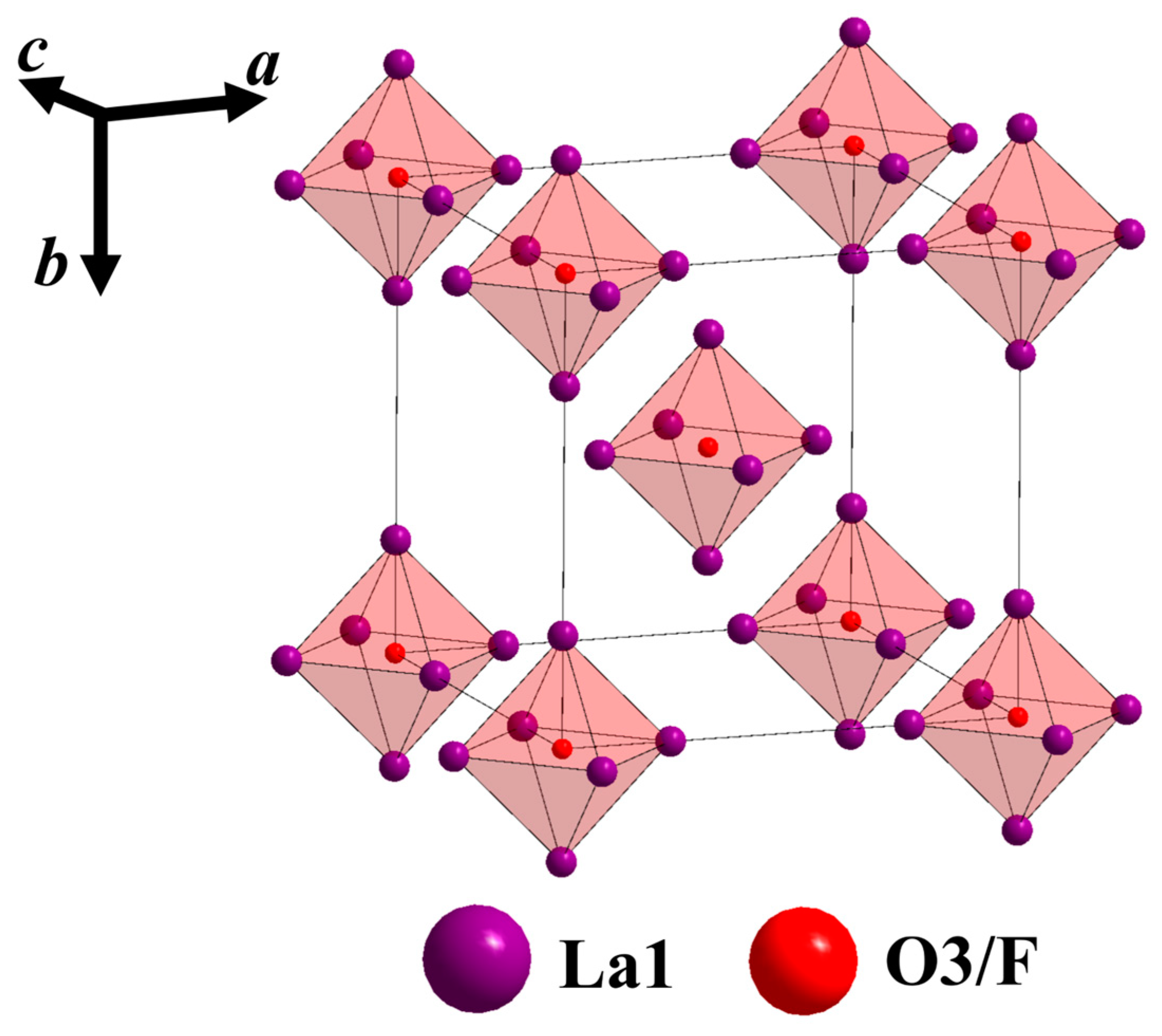
| Chemical formula | Li0.42La4.58Mo3O15.76±δF0.42±ε | Li0.42La4.58Mo3O15.76+δF0.42±ε |
| Space group, Z | , 4 | , 4 |
| T, °C | 20 | −183 |
| a, Å | 11.2706(1) | 11.2501(1) |
| V, Å3 | 1431.66(1) | 1423.87(1) |
| D, g/cm3 | 5.506 | 5.536 |
| Radiation; λ, Å | Mo Kα; 0.71073 | Mo Kα; 0.71073 |
| μ, mm−1 | 15.964 | 16.051 |
| Sample size, mm | 0.233 × 0.178 × 0.172 | 0.233 × 0.178 × 0.172 |
| Diffractometer | Rigaku XtaLAB Synergy-DW, HyPix-Arc 150 | Rigaku XtaLAB Synergy-DW, HyPix-Arc 150 |
| Scan mode | ω | ω |
| Absorption correction; Tmin, Tmax, | Gaussian; 0.092, 0.275, | Gaussian; 0.138, 1.000, |
| θmax, deg | 59.71 | 59.89 |
| Ranges of indices h, k, l | −25 ≤ h ≤ 25, −27 ≤ k ≤ 27, −27 ≤ l ≤ 27 | −27 ≤ h ≤ 27, −27 ≤ k ≤ 27, −25 ≤ l ≤ 25 |
| Number of reflections: measured/unique, Rint/I > 3σ(I) | 1220187/1820, 0.06/580 | 822160/1090, 0.11/559 |
| Refinement method | Least-squares method based on F | Least-squares method based on F |
| Number of parameters | 23 | 23 |
| R(|F|)/wR(|F|) | 0.0143/0.0257 | 0.0159/0.0248 |
| S | 2.37 | 2.24 |
| Δρmin/Δρmax | −0.80/1.05 | −0.99/1.27 |
| Programs | CrysAlis [19], JANA2006 [18] | CrysAlis [19], JANA2006 [18] |
Disclaimer/Publisher’s Note: The statements, opinions and data contained in all publications are solely those of the individual author(s) and contributor(s) and not of MDPI and/or the editor(s). MDPI and/or the editor(s) disclaim responsibility for any injury to people or property resulting from any ideas, methods, instructions or products referred to in the content. |
© 2023 by the authors. Licensee MDPI, Basel, Switzerland. This article is an open access article distributed under the terms and conditions of the Creative Commons Attribution (CC BY) license (https://creativecommons.org/licenses/by/4.0/).
Share and Cite
Orlova, E.I.; Sorokin, T.A.; Kvartalov, V.B.; Antipin, A.M.; Novikova, N.E.; Kharitonova, E.P.; Sorokina, N.I.; Alekseeva, O.A.; Voronkova, V.I. Rare-Earth Fluorite-like Li0.42La4.58Mo3O15.76±δF0.42±ε Molybdates: Crystal Growth and Atomic Structure. Crystals 2023, 13, 1009. https://doi.org/10.3390/cryst13071009
Orlova EI, Sorokin TA, Kvartalov VB, Antipin AM, Novikova NE, Kharitonova EP, Sorokina NI, Alekseeva OA, Voronkova VI. Rare-Earth Fluorite-like Li0.42La4.58Mo3O15.76±δF0.42±ε Molybdates: Crystal Growth and Atomic Structure. Crystals. 2023; 13(7):1009. https://doi.org/10.3390/cryst13071009
Chicago/Turabian StyleOrlova, Ekaterina I., Timofei A. Sorokin, Vladimir B. Kvartalov, Alexander M. Antipin, Nataliya E. Novikova, Elena P. Kharitonova, Nataliya I. Sorokina, Olga A. Alekseeva, and Valentina I. Voronkova. 2023. "Rare-Earth Fluorite-like Li0.42La4.58Mo3O15.76±δF0.42±ε Molybdates: Crystal Growth and Atomic Structure" Crystals 13, no. 7: 1009. https://doi.org/10.3390/cryst13071009
APA StyleOrlova, E. I., Sorokin, T. A., Kvartalov, V. B., Antipin, A. M., Novikova, N. E., Kharitonova, E. P., Sorokina, N. I., Alekseeva, O. A., & Voronkova, V. I. (2023). Rare-Earth Fluorite-like Li0.42La4.58Mo3O15.76±δF0.42±ε Molybdates: Crystal Growth and Atomic Structure. Crystals, 13(7), 1009. https://doi.org/10.3390/cryst13071009







